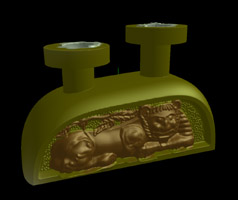Research project started
in 1998
Research grant ARP RG1/01, "Interactive function based shape
modeling", 2001-2004
Principal investigator and supervisor:
Alexei Sourin
Contributed researchers:
Konstantin Levinski (BSc, MSc, and PhD projects)
Lee Tiong Kuan (BEng project)
Suen Eng Kai (BEng project)
Research grant: NRF IDM grant NRF2008IDM-IDM004-002 "Visual and Haptic Rendering in Co-Space", S$1,248,000, 2008-2011
Last time updated on 28 March, 2010
| Dramatic advances in computer technology have revolutionized
the methods and tools of interactive 3D shape modeling where the unique geometric
reasoning of the human brain couples with the rapid computing and rendering abilities of
the computer. In this project we study interactive function-based shape modeling where
relatively small formulae are used rather than thousands of polygons. Interactive
modification of the function model with concurrent visualization of the respective part of
it lets us provide both the interactivity and any required level of detail leading
to photo-realistic appearance of the resulting shapes. |
| The modeling is being done with an interactive shape modeling program where the function model of the shape is sequentially modified with offset and set-theoretic operations. The final shape is represented in the data structure as a list of interactive operations over the basic shape. A pressure sensitive graphics tablet and a six degree of freedom haptic input device have been used to realistically simulate the depth of penetration of the tools. For visualization,we have developed special fast interactive ray tracing and interactive polygonization algorithms. Bounding shapes together with the spatial organization of the function model provide the required fast function evaluation that is usually a bottleneck for function-based shape modeling systems. The software runs on common PCs. In this page, the artistic application of interactive function-based shape modeling is presented. |
| Embossing is the art of decorating metals. In this technique, the ornament is raised from the back of the metal by means of hammers and punches followed by hammering from the front, which is called chasing. Embossing has been used extensively throughout the history of metalworking. It achieved widespread popularity in Europe during the 16th, 17th, and 18th centuries. One of the places where this art originated from is the Caucasus Mountains. |
|
|
|
|
Tools for embossing. |
Tracing the contours. |
Bossing up the relief. |
The resulted
embossing. |
|
|
|
|
Pressure sensitive tablet used in the project.
|
Tracing the contours.
|
Making relief areas
|
Embossed region.
|
|
||
"Girl
with a candle". |
Doing
virtual embossing with a pressure sensitive graphics tablet. |
"Girl
with a candle". |
|
|
|
"Seashells". |
"Unruly
horses". |
"Seashells". |
|
|
|
"Souliko". |
"When
the trees were tall" |
"The Jolly Good
Dragon"|
|
|
|
| "The
Jolly Good Dragon"
Click to enlarge. Virtual function-based embossing with the fast interactive polygonization, 2001 |
||
| Carving is always done with a cutter, generally by pressure from the hand. It detaches material in cutting. The same mathematical model with slight modification is used for simulating this art. |
Virtual carving.
|
"Moscow nights"
|
|
|||
Real wooden board cut. |
"Sunset". |
||
|
A virtual crystal vase |
The original vase which inspired us |
||
 |
 |
|
Candlestick, 2004 Made with a new version of the interactive shape modeling program. CW2004 |
|
 |
|
| Mouth
of Truth, 2004 Made with a new version of the interactive shape modeling program. CW2004 |
|
Visit also Function-based
extension of VRML.
All of the 3D models will be made available for viewing there through the FShape
plug-in for VRML.
Selected Publications
|
K.Levinski and A.Sourin. Interactive Function-Based Shape Modelling, Computers & Graphics, Elsevier, 2007;31(1):66-76. A.Chong, K.Levinski and A.Sourin. Interactive Grid-based Free-Form Shape Modeling. IEEE CCGrid, 253-256, 2006 Alexei Sourin, Computer Graphics. From a Small Formula to Cyberworlds, Prentice Hall, Singapore, ISBN 9810675518, 362 pages, 2005. K.Levinski and A.Sourin, Interactive Function-Based Shape Modeling for Cyberworlds, 2004 International Conference on Cyberworlds, Tokyo, 18-20 November, 2004, pp.54-61. K.Levinski and A.Sourin, "Interactive function-based artistic shape modeling", 2002 International Symposium Cyber Worlds: Theory and Practice 2002, Tokyo, Japan 6-8 November, 2002 pp.521-528. K.Levinski and A.Sourin, "Interactive polygonisation for function-based shape modelling", Eurographics 2002, Short Presentations, ISSN 1017-4565, pp.71-79, 2002. A.Sourin, "Functionally based virtual computer art", The 2001 ACM Symposium on Interactive Computer Graphics, I3D2001, Research Triangle Park, NC, USA, 19-21, March, 2001, ACM ISBN: 1-58113-292-1, pp.77-84. A.Sourin,"Functionally based virtual embossing",The Visual Computer, 17 (2001), 4, pp.258-271. |
Copyright © 1996-2006 Alexei Sourin.
This material may not be published, modified or otherwise redistributed in whole or
part without prior approval.